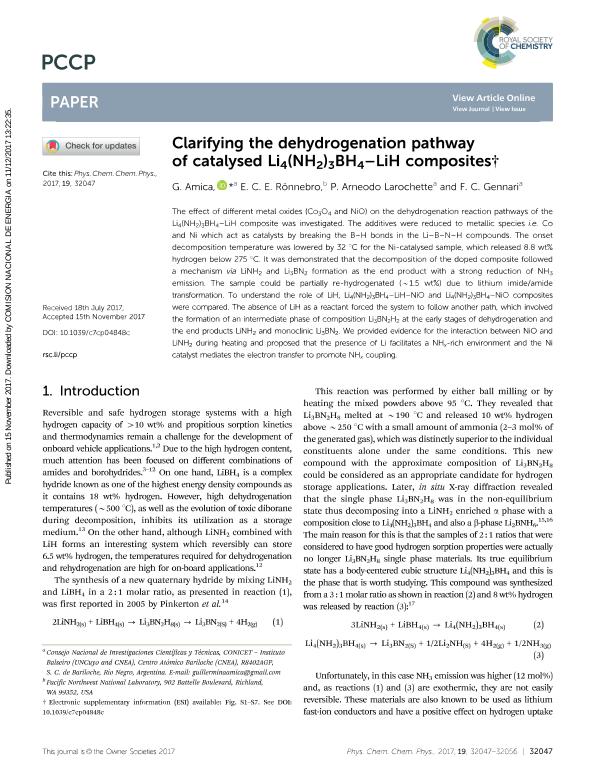Mostrar el registro sencillo del ítem
dc.contributor.author
Amica, Guillermina

dc.contributor.author
Rönnebro, E. C. E.
dc.contributor.author
Arneodo Larochette, Pierre Paul

dc.contributor.author
Gennari, Fabiana Cristina

dc.date.available
2019-01-18T17:50:22Z
dc.date.issued
2017-12-15
dc.identifier.citation
Amica, Guillermina; Rönnebro, E. C. E.; Arneodo Larochette, Pierre Paul; Gennari, Fabiana Cristina; Clarifying the dehydrogenation pathway of catalysed Li4(NH2)3BH4-LiH composite; Royal Society of Chemistry; Physical Chemistry Chemical Physics; 19; 15-12-2017; 32047-32056
dc.identifier.issn
1463-9076
dc.identifier.uri
http://hdl.handle.net/11336/68249
dc.description.abstract
The effect of different metal oxides (Co3O4 and NiO) on the dehydrogenation reactions pathways of the Li4(NH2)3BH4-LiH composite was investigated. The additives were reduced to metallic species i.e. Co and Ni which act as catalysts by breaking the B-H bonds in the Li-B-N-H compounds. The onset decomposition temperature was lowered by 32 °C for the Ni-catalysed sample, which released 8.8 wt% hydrogen below 275°C. It was demonstrated that the decomposition of the doped composite followed a mechanism via LiNH2 and Li3BN2 formation as the end product with a strong reduction of NH3 emission. The sample could be partially re-hydrogenated (~1.5 wt%) due to the lithium imide/amide transformation. To understand the LiH role, the Li4(NH2)3BH4-LiH-NiO and the Li4(NH2)3BH4-NiO composites were compared. The absence of LiH as a reactant forced the system to follow another path, which involved the formation of an intermediate phase of composition Li3BN2H2 at the early stages of dehydrogenation and the end products LiNH2 and monoclinic Li3BN2. We showed evidence for the interaction between NiO and LiNH2 during heating and we propose that the presence of Li facilitates a NHx-rich environment and the Ni catalyst mediates the electron transfer to promote NHx coupling.
dc.format
application/pdf
dc.language.iso
eng
dc.publisher
Royal Society of Chemistry

dc.rights
info:eu-repo/semantics/openAccess
dc.rights.uri
https://creativecommons.org/licenses/by-nc-sa/2.5/ar/
dc.subject
Hydrogen Storage
dc.subject
Lithium
dc.subject
Ni
dc.subject.classification
Química Orgánica

dc.subject.classification
Ciencias Químicas

dc.subject.classification
CIENCIAS NATURALES Y EXACTAS

dc.title
Clarifying the dehydrogenation pathway of catalysed Li4(NH2)3BH4-LiH composite
dc.type
info:eu-repo/semantics/article
dc.type
info:ar-repo/semantics/artículo
dc.type
info:eu-repo/semantics/publishedVersion
dc.date.updated
2019-01-14T14:18:46Z
dc.journal.volume
19
dc.journal.pagination
32047-32056
dc.journal.pais
Reino Unido

dc.journal.ciudad
Cambridge
dc.description.fil
Fil: Amica, Guillermina. Consejo Nacional de Investigaciones Científicas y Técnicas. Centro Científico Tecnológico Conicet - Patagonia Norte; Argentina. Comisión Nacional de Energía Atómica. Gerencia del Área de Energía Nuclear. Instituto Balseiro; Argentina
dc.description.fil
Fil: Rönnebro, E. C. E.. Pacific Northwest National Laboratory; Estados Unidos
dc.description.fil
Fil: Arneodo Larochette, Pierre Paul. Comisión Nacional de Energía Atómica. Gerencia del Área de Energía Nuclear. Instituto Balseiro; Argentina. Consejo Nacional de Investigaciones Científicas y Técnicas. Centro Científico Tecnológico Conicet - Patagonia Norte; Argentina
dc.description.fil
Fil: Gennari, Fabiana Cristina. Comisión Nacional de Energía Atómica. Gerencia del Área de Energía Nuclear. Instituto Balseiro; Argentina. Consejo Nacional de Investigaciones Científicas y Técnicas. Centro Científico Tecnológico Conicet - Patagonia Norte; Argentina
dc.journal.title
Physical Chemistry Chemical Physics

dc.relation.alternativeid
info:eu-repo/semantics/altIdentifier/doi/http://dx.doi.org/ 10.1039/C7CP04848C
dc.relation.alternativeid
info:eu-repo/semantics/altIdentifier/url/https://pubs.rsc.org/en/Content/ArticleLanding/2017/CP/C7CP04848C#!divAbstract
Archivos asociados
